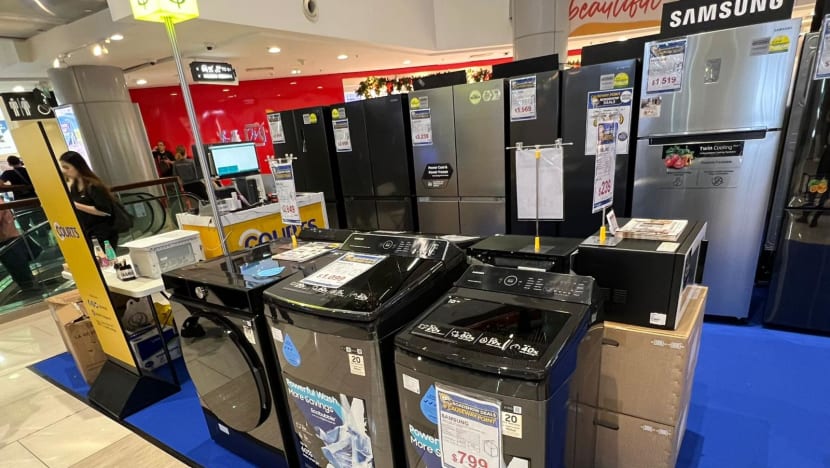S$300 Climate Vouchers: Where to use them and what appliances you can spend on
Looking for a new fridge or air-conditioner? All HDB households will soon receive S$300 in Climate Vouchers to buy energy- and water-efficient appliances.

Appliances on sale at Courts. (File photo: Facebook/Courts)

This audio is generated by an AI tool.
SINGAPORE: All Housing Board (HDB) households are set to receive S$300 in Climate Vouchers to purchase more energy- and water- efficient appliances.
Currently, only families in one-, two- and three-room HDB flats receive such vouchers. This will be expanded to all HDB households from Apr 15, Senior Minister of State for Sustainability and the Environment Amy Khor said on Monday (Mar 4).
WHAT ARE CLIMATE VOUCHERS?
The vouchers are part of the Climate Friendly Households Programme that was launched in November 2020 to help families in three-room or smaller HDB flats to save on utility bills.
Currently, they can be used to buy energy-efficient refrigerators, LED lights and water-efficient shower fittings.
The vouchers will soon be given to all HDB households from Apr 15 and can be used until December 2027. They can also be used for more items.
The Climate Vouchers will come in a mix of denominations – S$2, S$5, S$10 and S$50.
HOW TO CLAIM AND SPEND THE VOUCHERS
The process is similar to claiming Community Development Council (CDC) vouchers.
HDB households can claim their Climate Vouchers online at RedeemSG. They will have to log on with their Singpass accounts and only one household member needs to claim the vouchers.
An SMS from gov.sg with a link will be sent to the registered Singpass phone number of the person who claimed it. The link can then be shared with other household members to use the vouchers.
Those who require assistance can contact the National Environment Agency (NEA) through its hotline, said Dr Khor on Monday.
To use the vouchers, customers have to provide proof of address at participating retail outlets.
They can then choose the amount to spend and tap on "show voucher", which produces a QR code. After scanning the QR code, the amount will be deducted from the final bill.
WHAT ITEMS CAN THE VOUCHERS BE USED FOR?
The programme will be expanded from refrigerators, shower fittings and LED lights.
From Apr 15, these vouchers can soon be used to buy 10 types of energy- and water-efficient household products:
- Refrigerators – three ticks and above
- Air-conditioners – five ticks
- Washing machines – four ticks
- Shower fittings – three ticks
- LED lights – two ticks and above
- Water closets – three ticks
- Basin taps and mixers – three ticks
- Sink/bib taps and mixers – three ticks
- Heat pump water heaters
- Direct current fans
Direct current fans typically use up to 70 per cent less energy compared with alternating current fans.
The vouchers can be spent at 14 retailers: Audio House, Bathroom Warehouse, Best Denki, Cold Storage, Courts, FairPrice, Gain City, Giant, Harvey Norman, Mega Discount Store, Sheng Siong, TS Yong Trading, Chuan Heng Hardware Trading and Woodlands Domestic Electrical.

WHY SHOULD YOU CARE ABOUT TICKS?
In September 2014, NEA introduced a revised mandatory energy rating system for some types of home appliances.
The number of ticks on the energy label highlights the relative energy efficiency of an appliance, with more ticks indicating higher efficiency.
Items are rated from one to five ticks – with refrigerators only rated from one to four ticks.
Besides the efficiency of an appliance, the label includes the annual energy cost and energy consumption, as well as the brand, model and type of product.
The annual energy cost is estimated based on an assumed electricity price of 27 cents per kWh, typical household usage of an appliance and energy consumption.
"This (label) will help consumers better understand how the energy performance of the appliance they buy will translate into cost savings," said the National Climate Change Secretariat in 2014.
It was announced on Monday that the Mandatory Energy Labelling Scheme and Minimum Energy Performance Standards will also be extended to household water heaters and commercial refrigerators from Apr 1, 2025.
NEA will develop minimum energy standards to phase out the least energy-efficient water heaters and commercial fridges, and introduce an energy label with a five-tick rating scale for both appliances.
CHOOSING THE RIGHT SIZE
Not everyone needs a 600L refrigerator or 24,000 BTU air-conditioner. Fridges and air-con are among the most energy intensive home appliances.
According to NEA, while energy efficient models may have higher purchase prices than less efficient ones, they tend to have lower life cycle costs due to lower electricity costs over their lifetimes.
The estimated lifespan of a fridge is assumed to be 10 years, while that of air-conditioners is thought to be seven years.
The agency's Life Cycle Cost Calculator helps buyers tabulate the life cycle costs of different models of air-conditioners, fridges, clothes dryers and televisions.
.png?itok=OojVBkgi)
NEA advises people to buy the smallest fridge model that meets their needs.
They can consider whether additional features - such as automatic icemakers and through-the-door dispensers - are needed, as they increase energy use.
Those looking for new air-conditioners should also choose the right cooling capacity. Oversized or undersized air-conditioners operate inefficiently.
A two-tick model will cost about S$303 more in electricity bills a year, as compared with a five-tick air-conditioner. This is based on an electricity cost of 29.9 cents per kWh.















